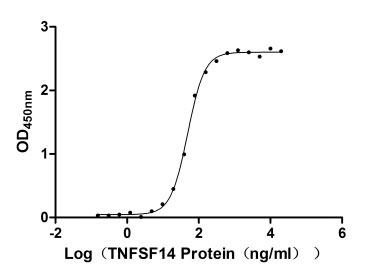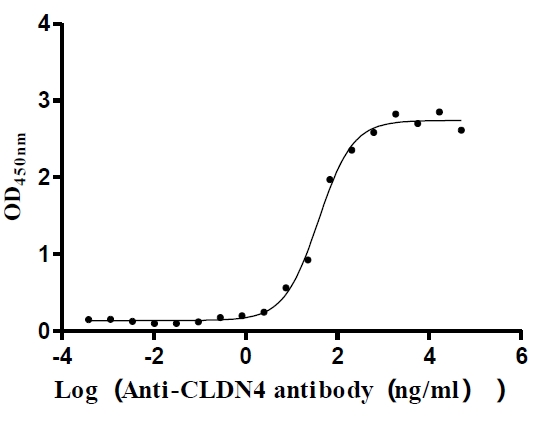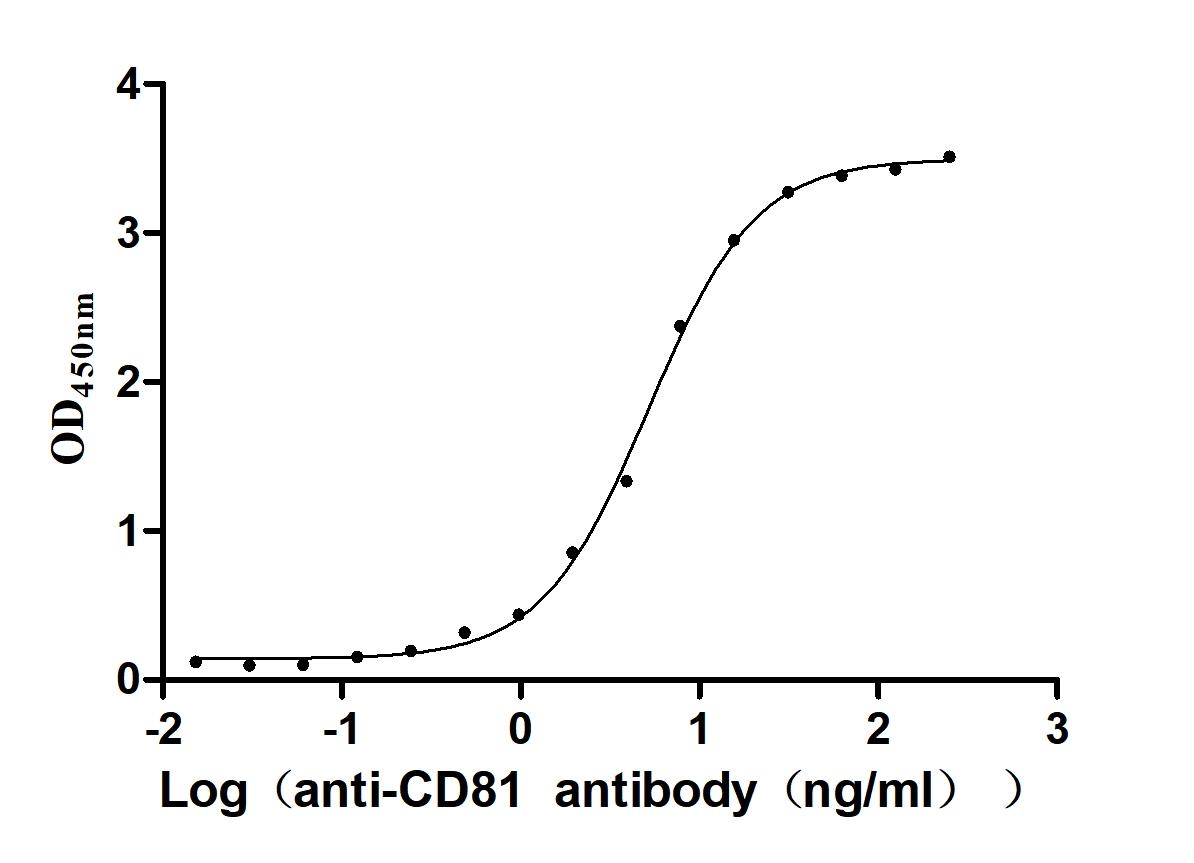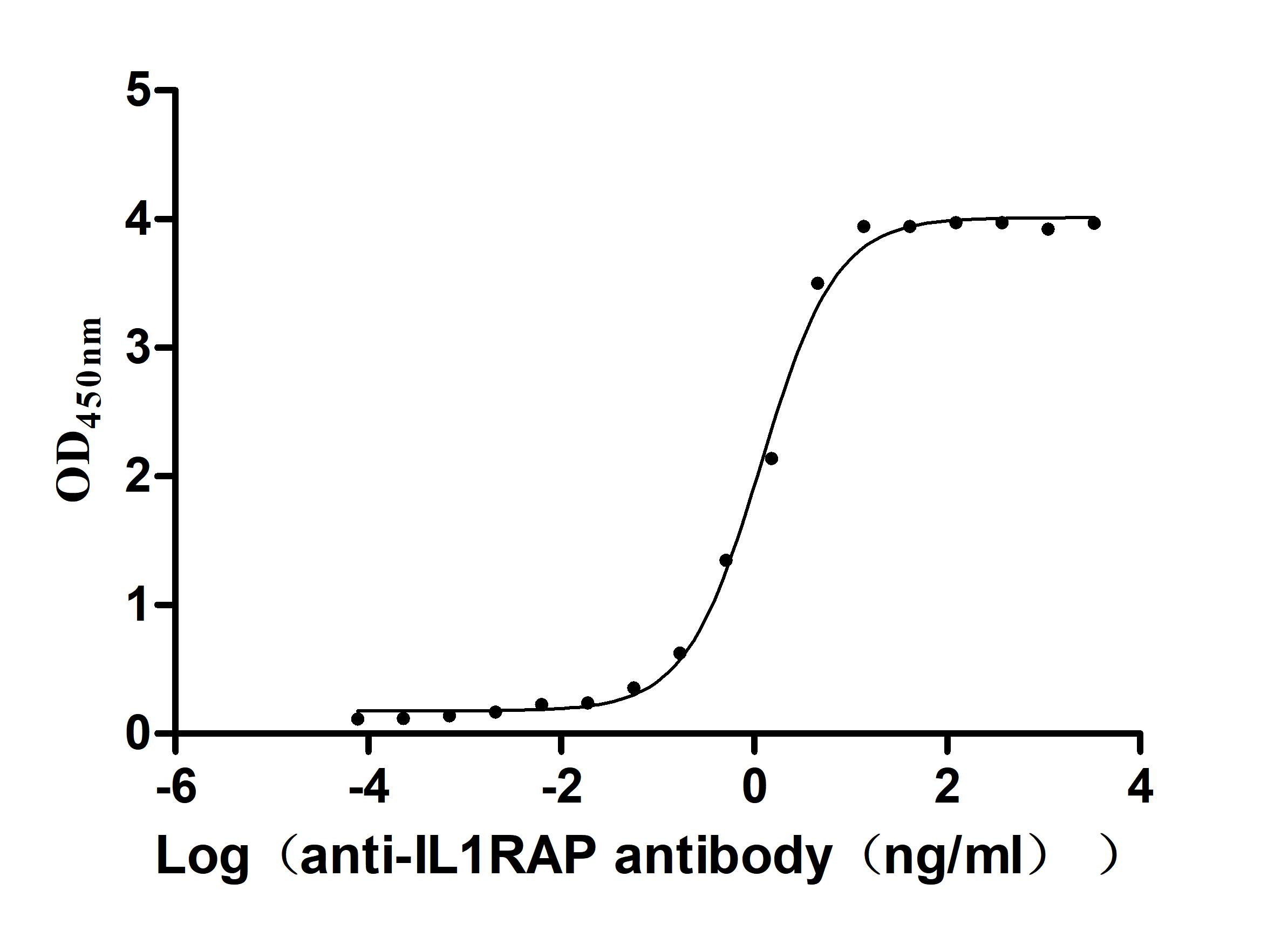Recombinant Mouse Ubiquitin-protein ligase E3A (Ube3a), partial
-
中文名稱:小鼠Ube3a重組蛋白
-
貨號:CSB-BP025488MO
-
規(guī)格:
-
來源:Baculovirus
-
其他:
-
中文名稱:小鼠Ube3a重組蛋白
-
貨號:CSB-EP025488MO-B
-
規(guī)格:
-
來源:E.coli
-
共軛:Avi-tag Biotinylated
E. coli biotin ligase (BirA) is highly specific in covalently attaching biotin to the 15 amino acid AviTag peptide. This recombinant protein was biotinylated in vivo by AviTag-BirA technology, which method is BriA catalyzes amide linkage between the biotin and the specific lysine of the AviTag.
-
其他:
產(chǎn)品詳情
-
純度:Greater than 85% as determined by SDS-PAGE.
-
基因名:Name:Ube3a
-
Uniprot No.:
-
別名:Ube3a; Ubiquitin-protein ligase E3A; EC 2.3.2.26; HECT-type ubiquitin transferase E3A; Oncogenic protein-associated protein E6-AP
-
種屬:Mus musculus (Mouse)
-
蛋白長度:Partial
-
表達(dá)區(qū)域:542-870aa
-
氨基酸序列NPADLKKQLYVEFEGEQGVDEGGVSKEFFQLVVEEIFNPDIGMFTYDEATKLFWFNPSSFETEGQFTLIGIVLGLAIYNNCILDVHFPMVVYRKLMGKKGTFRDLGDSHPVLYQSLKDLLEYEGSVEDDMMITFQISQTDLFGNPMMYDLKENGDKIPITNENRKEFVNLYSDYILNKSVEKQFKAFRRGFHMVTNESPLKYLFRPEEIELLICGSRNLDFQALEETTEYDGGYTRESVVIREFWEIVHSFTDEQKRLFLQFTTGTDRAPVGGLGKLKMIIAKNGPDTERLPTSHTCFNVLLLPEYSSKEKLKERLLKAITYAKGFGML
-
蛋白標(biāo)簽:Tag?type?will?be?determined?during?the?manufacturing?process.
The tag type will be determined during production process. If you have specified tag type, please tell us and we will develop the specified tag preferentially. -
產(chǎn)品提供形式:Lyophilized powder
Note: We will preferentially ship the format that we have in stock, however, if you have any special requirement for the format, please remark your requirement when placing the order, we will prepare according to your demand. -
復(fù)溶:We recommend that this vial be briefly centrifuged prior to opening to bring the contents to the bottom. Please reconstitute protein in deionized sterile water to a concentration of 0.1-1.0 mg/mL.We recommend to add 5-50% of glycerol (final concentration) and aliquot for long-term storage at -20℃/-80℃. Our default final concentration of glycerol is 50%. Customers could use it as reference.
-
儲存條件:Store at -20°C/-80°C upon receipt, aliquoting is necessary for mutiple use. Avoid repeated freeze-thaw cycles.
-
保質(zhì)期:The shelf life is related to many factors, storage state, buffer ingredients, storage temperature and the stability of the protein itself.
Generally, the shelf life of liquid form is 6 months at -20°C/-80°C. The shelf life of lyophilized form is 12 months at -20°C/-80°C. -
貨期:Delivery time may differ from different purchasing way or location, please kindly consult your local distributors for specific delivery time.Note: All of our proteins are default shipped with normal blue ice packs, if you request to ship with dry ice, please communicate with us in advance and extra fees will be charged.
-
注意事項:Repeated freezing and thawing is not recommended. Store working aliquots at 4°C for up to one week.
-
Datasheet :Please contact us to get it.
相關(guān)產(chǎn)品
靶點詳情
-
功能:E3 ubiquitin-protein ligase which accepts ubiquitin from an E2 ubiquitin-conjugating enzyme in the form of a thioester and transfers it to its substrates. Several substrates have been identified including the ARNTL/BMAL1, ARC, RAD23A and RAD23B, MCM7 (which is involved in DNA replication), annexin A1, the PML tumor suppressor, and the cell cycle regulator CDKN1B. Additionally, may function as a cellular quality control ubiquitin ligase by helping the degradation of the cytoplasmic misfolded proteins. Finally, UBE3A also promotes its own degradation in vivo. Plays an important role in the regulation of the circadian clock: involved in the ubiquitination of the core clock component ARNTL/BMAL1, leading to its proteasomal degradation. Acts as a regulator of synaptic development by mediating ubiquitination and degradation of ARC. Synergizes with WBP2 in enhancing PGR activity.
-
基因功能參考文獻(xiàn):
- Paternal UBE3A also partially colocalizes with a marker of neural progenitors, SOX2, implying that relaxed or incomplete imprinting of paternal Ube3a reflects an overall immature molecular phenotype PMID: 27306933
- Using in vivo patch-clamp electrophysiology, study measured the visually evoked responses to square-wave drifting gratings in L2/3 regular-spiking (RS) neurons in control mice, Ube3a-deficient mice (Angelman syndrome model), and mice in which Ube3a was conditionally reinstated in GABAergic neurons; found that Ube3a-deficient mice exhibited enhanced pyramidal neuron excitability in vivo as well as weaker orientation tuning PMID: 28468997
- Findings show neuronal overexpression of Ube3a isoform 2 causes phenotypes translatable to neurodevelopmental disorders. PMID: 29016856
- Findings suggest that aberrant function of Ube3a could influence the progression of AD and restoring normal level of Ube3a might be beneficial for AD. PMID: 29016862
- Encephalomyocarditis virus (EMCV) 3C protease accumulates to higher levels in EMCV-infected E6AP knockdown cells than in control cells, indicating a role for E6AP in in vivo 3C protease concentration regulation. PMID: 29054411
- The expression of three tumor suppressor genes encoded in the INK4/ARF locus (p15(INK4b), p16(INK4a), and p19(ARF)) was decreased in E6AP(-/-) embryo fibroblasts. PMID: 28074012
- Maternal loss of Ube3a affects nociception via a central, but not peripheral mechanism. PMID: 28931574
- Our findings suggest that UBE3A may act locally to regulate individual synapses while also mediating global, neuronwide influences through the regulation of gene transcription PMID: 27339004
- We report that mice with maternally-inherited deletions of Ube3a that models Angelman syndrome show an increased social preference/interaction. PMID: 28411125
- increasing UBE3A in the nucleus downregulates the glutamatergic synapse organizer Cbln1, which is needed for sociability in mice PMID: 28297715
- Based on our findings, we propose that imprinting of UBE3A does not function to reduce the dosage of UBE3A in neurons but rather to regulate some other, as yet unknown, aspect of gene expression or protein function PMID: 28515788
- the role of UBE3A is investigated in neurite contact guidance during neuronal development, is reported. PMID: 26845073
- Results substantiate GABAergic Ube3a loss as the principal cause of circuit hyperexcitability in Angelman syndrome mice, lending insight into ictogenic mechanisms in AS. PMID: 27021170
- Loss of Ube3a from tyrosine hydroxylase-expressing neurons impairs mesoaccumbal, non-canonical GABA co-release and enhances reward-seeking behaviour measured by optical self-stimulation. PMID: 26869263
- Results suggest that the phenotypes observed in Angelman syndrome mice may be modulated by factors independent of Ube3a genotype PMID: 26028516
- UBE3A dampens ERK pathway signalling in HPV E6 transformed HeLa cells PMID: 25815718
- The normal window of development in Angelman syndrome patients is supported by an incompletely silenced paternal allele in developing neurons, resulting in a relative preservation of Ube3a expression during this crucial epoch of early development. PMID: 25894543
- Inactivation of Ube3a expression elevates BMAL1 levels in brain regions that control circadian behavior of AS-model mice, indicating an important role for Ube3a in modulating BMAL1 turnover. PMID: 25660546
- This study demonstrated that abnormal sleep patterns arise from a deficit in accumulation of sleep drive, uncovering the Ube3a gene as a novel genetic regulator of sleep homeostasis PMID: 26446213
- The deficiency of Ube3a in Huntington's disease (HD) mice brain also caused significant increase in global aggregates load, and these aggregates were less ubiquitinated when compared with age-matched HD mice. PMID: 25027318
- There are distinct neurodevelopmental windows when Ube3a restoration rescues Angelman-syndrome-like phenotypes. Motor deficits are rescued in adolescence. Anxiety, repetitive behavior, and epilepsy are rescued in early development. PMID: 25866966
- Mature oligodendrocytes express Ube3a in the cortex and white matter tracts during development. PMID: 24254964
- findings provide novel insight into the regulation of Ube3a by synaptic activity and its potential role in kinase regulation PMID: 24434871
- These studies demonstrate the feasibility and utility of unsilencing the paternal copy of Ube3a via targeting Ube3a-ATS as a treatment for Angelman syndrome. PMID: 24385930
- Activating UBE3A disrupts circadian oscillations in mouse embryonic fibroblasts and rhythms in endogenous mRNA and protein levels of BMAL1. PMID: 24728990
- Aging-dependent Ube3a levels result in differential ubiquitination and degradation of Htt fragments, thereby contributing to the age-related neurotoxicity of mutant Htt. PMID: 24706802
- This study demonistrated that Changes in mGlu5 receptor-dependent synaptic plasticity and coupling to homer proteins in the hippocampus of Ube3A hemizygous mice. PMID: 24672001
- These results demonstrate that UBE3A plays a role in MC1R transcriptional regulation. PMID: 21733131
- E6AP may negatively control adipogenesis by inhibiting C/EBPalpha expression. PMID: 23762344
- MeCP2 and E6AP play a role in the transcriptional control of common target gene expression. PMID: 23791832
- This study described a novel phenotype of severely distended Golgi cisternae in the Angelman syndrome model mouse. PMID: 23447592
- The present study is the first to determine that the Ube3a protein ablation seen in the Angelman syndrome mouse model is also characteristic of Angelman syndrome patients PMID: 22560727
- findings showed that Ube3a-ATS is an atypical RNAPII transcript that functions to suppress paternal Ube3a expression PMID: 22493002
- the loss of function of Ube3a might be associated with the synaptic abnormalities observed in HD. PMID: 22787151
- study reports that Ube3a regulates glucocorticoid receptor (GR) transactivation; the GR signaling pathway is disrupted in Ube3a-maternal-deficient mice brain that eventually leads to increased susceptibility to stress and anxiety in these Angelman syndrome mice PMID: 22215440
- This study demonistrated that Ube3a deficices mice product produces an excitatory/inhibitory imbalance through neuron type-specific synaptic in visual cortex. PMID: 22681684
- our study implicates E6AP as an important regulator of the cellular response to stress, in particular through the regulation of replicative and oncogene-induced senescence. PMID: 21927031
- The results suggest that Ube3a gene dosage may contribute to the autism traits of individuals with maternal 15q11-13 duplication and support the idea that increased E3A ubiquitin ligase gene dosage results in reduced excitatory synaptic transmission. PMID: 21974935
- In a mouse model of Angelman syndrome, since hippocampal and Purkinje cells have the highest expression of UBE3A in a mouse model of Angelman syndrome, these cells would have the greatest sensitivity to the UBE3A m-\p+ maternal\paternal genotype. PMID: 19563863
- HERC2 acts as a regulator of E6AP. PMID: 21493713
- The levels of total Akt and phosphorylated Akt (active Akt) are increased in E6-AP overexpressing prostate gland and LNCaP cells suggesting that E6-AP regulates the PI3K-Akt signaling pathway. PMID: 20826237
- Data show RNA interference that targets Ube3a in P19 cells caused downregulation of Mc1r and Nr4a2, whereas overexpression of Ube3a results in the upregulation of Mc1r and Nr4a2. PMID: 20571502
- Ube3a exhibits brain cell type-specific imprinting, with monoallelic expression from the maternal allele in neurons, but biallelic expression in glial cells. The antisense Ube3a transcript is reciprocally imprinted only in neurons. PMID: 12668607
- Ube3a expression is primarily neuronal in all brain regions and present in GABAergic interneurons as well as principal neurons. PMID: 20423730
- E6-associated protein is required for human papillomavirus type 16 E6 to cause cervical cancer. PMID: 20530688
- polycomb protein Ring1B regulation by self-ubiquitination or by E6-AP may have implications to the pathogenesis of Angelman syndrome PMID: 20351251
- As demonstrated by optical imaging, rapid ocular dominance plasticity after brief monocular deprivation was severely impaired during the critical period in the visual cortex of Ube3a maternal-deficient (m-/p+) mice. PMID: 20212164
- Disruption of Ube3A function in neurons leads to an increase in Arc expression and a concomitant deregulation in AMPA receptors at synapses; which may contribute to the cognitive dysfunction that occurs in Angelman Syndrome. PMID: 20211139
- The imprinted Ube3a antisense transcript is regulated by the U exons rather than Snurf/Snrpn exon 1 (Ube3a antisense RNA). PMID: 15226413
- loss of E6AP catalytic activity and improper regulation of E6AP substrate are important in the development of Angelman syndrome PMID: 15263005
顯示更多
收起更多
-
亞細(xì)胞定位:Cytoplasm. Nucleus.
-
組織特異性:Widely expressed. Most abundant in brain, heart and thymus.
-
數(shù)據(jù)庫鏈接:
Most popular with customers
-
Recombinant Human Tumor necrosis factor ligand superfamily member 14 (TNFSF14), partial (Active)
Express system: Mammalian cell
Species: Homo sapiens (Human)
-
Recombinant Human Claudin-4 (CLDN4)-VLPs (Active)
Express system: Mammalian cell
Species: Homo sapiens (Human)
-
Recombinant Human Microtubule-associated protein tau (MAPT) (Active)
Express system: Mammalian cell
Species: Homo sapiens (Human)
-
Recombinant Human CD81 antigen (CD81), partial (Active)
Express system: Mammalian cell
Species: Homo sapiens (Human)
-
Recombinant Human Interleukin-1 receptor accessory protein (IL1RAP), partial (Active)
Express system: Mammalian cell
Species: Homo sapiens (Human)




-AC1.jpg)











